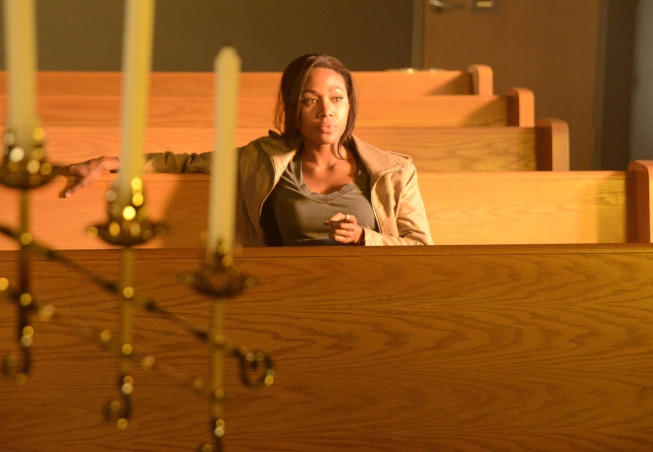Sleepy Hollow, Season 1, Episode 5: “John Doe″
Written by Melissa Blake
Directed by Ernest Dickerson
Airs Mondays at 9:00 PM ET on Fox
In another wacky episode of Sleepy Hollow, Ichabod Crane (Tom Mison) and Abbie Mills (Nicole Beharie) meet a young boy, who runs through the woods and faints. He is wearing antiquated clothes, only speaks Middle English, and is covered in black veins. “John Doe” has the most detective work of any Sleepy Hollow episode and does an excellent job developing Abbie’s character as she is faced with even more bizarre events. Ernest Dickerson (The Walking Dead, The Wire) also turns in the best camera work since “Pilot”. However, the scenes involving Crane’s wife Katrina (Katia Winter) fall flat and make Sleepy Hollow‘s overarching plot even more confusing. She is reduced to a one-note exposition provider, and even her exposition makes almost no sense. However, its mix of American history and Biblical mythology with a dash of humor makes most of “John Doe” an entertaining watch.
After delving into Abbie’s past last episode, writer Melissa Blake focuses on her relationship with Crane and response to the strange happenings around Sleepy Hollow. Because she needs empirical proof to believe things, Abbie is not a good fit in her role as one of the two witnesses prophesied in the Book of Revelation. “John Doe” explores her problems with believing in the supernatural and lets her faith slowly develop throughout the episode. In conjunction with these events, “John Doe” also looks at Captain Frank Irving’s (Orlando Jones) motivation for keeping Crane on as a police consultant. Irving is making slow steps towards becoming a “believer” and covers for Abbie and Crane when her ex-boyfriend and police detective Luke Morales (Nicholas Gonzalez) makes inquiries into Crane’s origins. Even though Sleepy Hollow is primarily a concept driven show, the writers still find time to develop the show’s lead characters and explore their reactions to the phenomena around them.
Ernest Dickerson adds some atmosphere and beautiful recurring motifs to Sleepy Hollow through his directing in “John Doe”. He takes his time with shots and lingers on big moments, like an EMT getting infected by the Horseman of Pestilence. Dickerson also uses quick camera pans to show the characters’ disorientation. This technique works well when Crane and Abbie make a discovery about the strange boy’s place of origin and is also used whenever Crane talks to his wife Katrina in Limbo. Finally, Dickerson focuses on recurring images to add depth to Blake’s script and provide some foreshadowing. His biggest motif is an overhead shot of bubbling water that shows up several times in the episode.
Despite its strengths in directing and characterization, “John Doe” grinds to halt every time Katrina shows up. Her exposition in “Pilot” was useful in explaining the show’s premise, but it is redundant in this episode. Five episodes in, and the show’s mythology already has a “Big Bad” (Moloch) and several other major players (Four Horsemen, various witches and demons), but Katrina complicates things by having a “secret” and throwing in some vague premonitions about peoples’ souls. Her scenes with Crane kill the episode’s suspense, and Winter and Mison have less than believable chemistry.
Even though it has its share of plot contrivances (like most episodes of Sleepy Hollow) and some confusing bits, “John Doe” is yet another fun episode of Sleepy Hollow. Melissa Blake writes some witty dialogue for Crane and Abbie, and Tom Mison continues to play Crane completely straight. The premise of “John Doe” is quite unique for a stand-alone episode of a supernatural show and builds on Sleepy Hollow’s roots in early American history and the Book of Revelation. If Sleepy Hollow continues to develop its characters and streamline its mythology, it has potential to be one of the strongest genre shows on television.






